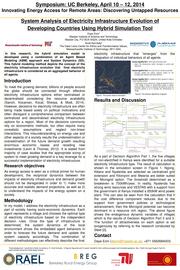Difference between revisions of "System Analysis of Electricity Infrastructure Evolution Using Hybrid Method Simulation Tool"
From energypedia
***** (***** | *****) (Created page with " [[File:MES Berkley small.png|center|800px|Innovating Energy Access for Remote Areas: Discovering Untapped Resources|alt=Innovating Energy Access for Remote Areas: Discovering...") |
***** (***** | *****) m |
||
| Line 22: | Line 22: | ||
{| border="0" cellspacing="3" cellpadding="5" style="width: 800px;" | {| border="0" cellspacing="3" cellpadding="5" style="width: 800px;" | ||
|- | |- | ||
| − | | Hybrid modeling method proposed in our work depicts the concept of the electricity infrastructure evolution. In our | + | | Hybrid modeling method proposed in our work depicts the concept of the electricity infrastructure evolution. In our model, we address the electricity infrastructure as a part of society having socio-economic dynamics. Each agent represents a village and chooses the optimal type of electricity infrastructure based on the independent decision rules. Once the type of infrastructure is determined, the system dynamics of the local environment drives the embedded agent behaviors. The combination of different methodologies can effectively describe the final electricity infrastructure that “emerges” from the integration of individual behaviors of all agents. The study shows sample runs of simulation, yet future work needs to be done followed by case studies<ref>System Analysis of Electricity Infrastructure Evolution Using Hybrid Method Simulation Tool. Daye Eom and Scott Kennedy.</ref>. |
| <span style="line-height: 20.400001525878906px;">[[File:System Analysis of Electricity Infrastructure Evolution Using Hybrid Method Simulation Tool.pdf|border|right|180px|System Analysis of Electricity Infrastructure Evolution Using Hybrid Method Simulation Tool.pdf|alt=File:Experience from First Solar Mini Grid Service in Bangladesh.pdf]]</span> | | <span style="line-height: 20.400001525878906px;">[[File:System Analysis of Electricity Infrastructure Evolution Using Hybrid Method Simulation Tool.pdf|border|right|180px|System Analysis of Electricity Infrastructure Evolution Using Hybrid Method Simulation Tool.pdf|alt=File:Experience from First Solar Mini Grid Service in Bangladesh.pdf]]</span> | ||
|} | |} | ||
| Line 34: | Line 34: | ||
__NOEDITSECTION__ | __NOEDITSECTION__ | ||
| + | [[Category:Electric_Connections]] | ||
| + | [[Category:Electricity]] | ||
| + | [[Category:Hybrid_Systems]] | ||
[[Category:Conference_Documentation]] | [[Category:Conference_Documentation]] | ||
| − | |||
| − | |||
| − | |||
Revision as of 08:02, 5 May 2014
System Analysis of Electricity Infrastructure Evolution Using Hybrid Method Simulation Tool
Presenter: Daye Eom (Masdar Institute of Science and Technology)
Overview
| Hybrid modeling method proposed in our work depicts the concept of the electricity infrastructure evolution. In our model, we address the electricity infrastructure as a part of society having socio-economic dynamics. Each agent represents a village and chooses the optimal type of electricity infrastructure based on the independent decision rules. Once the type of infrastructure is determined, the system dynamics of the local environment drives the embedded agent behaviors. The combination of different methodologies can effectively describe the final electricity infrastructure that “emerges” from the integration of individual behaviors of all agents. The study shows sample runs of simulation, yet future work needs to be done followed by case studies[1]. |
References
- ↑ System Analysis of Electricity Infrastructure Evolution Using Hybrid Method Simulation Tool. Daye Eom and Scott Kennedy.





















